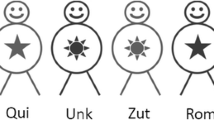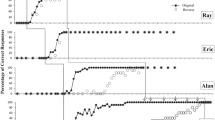Abstract
Researchers have demonstrated the efficacy of picture prompts on the acquisition of intraverbals (Coon & Miguel in Journal of Applied Behavior Analysis, 45, 657–666, 2012; Goldsmith, LeBlanc, & Sautter in Research in Autism Spectrum Disorders, 1, 1–13, 2007; Ingvarsson & Hollobaugh in Journal of Applied Behavior Analysis, 44, 659–664, 2011; Ingvarsson & Le in The Analysis of Verbal Behavior, 27, 75–93, 2011; Miguel, Petursdottir, & Carr in The Analysis of Verbal Behavior, 21, 27–41, 2005; Partington & Bailey in The Analysis of Verbal Behavior, 11, 9–18, 1993). However, no one (to our knowledge) has determined the effects of picture prompts on the variability of responding during intraverbal categorization. We evaluated the use of a scenic picture prompt on response variability during the acquisition of intraverbal categorization with 4 children diagnosed with autism. All children mastered the task and initially demonstrated varied responding. However, responding eventually became invariant for all children. These results demonstrate the efficacy of a scenic picture prompt for teaching children with autism intraverbal categorization and for producing initial response variability. Additional research should be conducted to determine teaching procedures that promote continued varied responding for individuals with autism.


Similar content being viewed by others
References
American Psychiatric Association. (2013). Diagnostic and statistical manual of mental disorders (5th ed.). Arlington, VA: American Psychiatric Publishing.
Antonitis, J. J. (1951). Response variability in the white rat during conditioning, extinction, and reconditioning. Journal of Experimental Psychology, 42, 273–281. https://doi.org/10.1037/h0060407
Braam, S. J., & Poling, A. (1983). Development of intraverbal behavior in mentally retarded individuals through transfer of stimulus control procedures: Classification of verbal responses. Applied Research in Mental Retardation, 4, 279–302. https://doi.org/10.1016/0270-3092(83)90030-9
Carroll, R. A., & Kodak, T. (2015). Using instructive feedback to increase response variability during intraverbal training for children with autism spectrum disorder. The Analysis of Verbal Behavior, 31, 183–199. https://doi.org/10.1007/s40616-015-0039-x
Contreras, B. P., & Betz, A. M. (2016). Using lag schedules to strengthen the intraverbal repertoires of children with autism. Journal of Applied Behavior Analysis, 49, 3–16. https://doi.org/10.1002/jaba.271
Coon, J. T., & Miguel, C. F. (2012). The role of increased exposure to transfer-of-stimulus-control procedures on the acquisition of intraverbal behavior. Journal of Applied Behavior Analysis, 45, 657–666. https://doi.org/10.1901/jaba.2012.45-657
Dracobly, J. D., Dozier, C. L., Briggs, A. M., & Juanico, J. F. (2017). An analysis of procedures that affect response variability. Journal of Applied Behavior Analysis, 50, 600–621. https://doi.org/10.1002/jaba.392
Dunn, L. M., & Dunn, D. M. (2007). Peabody picture vocabulary test manual (4th ed.). Minneapolis, MN: Pearson.
Feng, H., Chou, W., & Lee, G. T. (2015). Effects of tact prompts on acquisition and maintenance of divergent intraverbal responses by a child with autism. Focus on Autism and Other Developmental Disabilities, 32, 133–141. https://doi.org/10.1177/1088357615610540
Goldsmith, T. R., LeBlanc, L. A., & Sautter, R. A. (2007). Teaching intraverbal behavior to children with autism. Research in Autism Spectrum Disorders, 1, 1–13. https://doi.org/10.1016/j.rasd.2006.07.001
Grannan, L., & Rehfeldt, R. A. (2012). Emergent intraverbal responses via tact and match-to-sample instruction. Journal of Applied Behavior Analysis, 45, 601–605. https://doi.org/10.1901/jaba.2012.45-601
Ingvarsson, E. T., & Hollobaugh, T. (2011). A comparison of prompting tactics to establish intraverbals in children with autism. Journal of Applied Behavior Analysis, 44, 659–664. https://doi.org/10.1901/jaba.2011.44-659
Ingvarsson, E. T., & Le, D. D. (2011). Further evaluation of prompting tactics for establishing intraverbal responding in children with autism. The Analysis of Verbal Behavior, 27, 75–93. https://doi.org/10.1007/BF03393093
Karsten, A. M., & Carr, J. E. (2009). The effects of differential reinforcement of unprompted responding on the skill acquisition of children with autism. Journal of Applied Behavior Analysis, 42, 327–334. https://doi.org/10.1901/jaba.2009.42-327
Kisamore, A. N., Carr, J. E., & LeBlanc, L. A. (2011). Training preschool children to use visual imagining as a problem-solving strategy for complex categorization tasks. Journal of Applied Behavior Analysis, 44, 255–278. https://doi.org/10.1901/jaba.2011.44-255
Lee, R., McComas, J. J., & Jawor, J. (2002). The effects of differential and lag reinforcement schedules on varied verbal responding by individuals with autism. Journal of Applied Behavior Analysis, 35, 391–402. https://doi.org/10.1901/jaba.2002.35-391
Lee, R., & Sturmey, P. (2006). The effects of lag schedules and preferred materials on variable responding in students with autism. Journal of Autism and Developmental Disorders, 36(3), 421–428. https://doi.org/10.1007/s10803-006-0080-7
Luciano, M. C. (1986). Acquisition, maintenance, and generalization of productive intraverbal behavior through transfer of stimulus control procedures. Applied Research in Mental Retardation, 7, 1–20. https://doi.org/10.1016/0270-3092(86)90014-7
Miguel, C. F., Petursdottir, A. I., & Carr, J. E. (2005). The effects of multiple-tact and receptive-discrimination training on the acquisition of intraverbal behavior. The Analysis of Verbal Behavior, 21, 27–41. https://doi.org/10.1007/BF03393008
Neuringer, A., Kornell, N., & Olufs, M. (2001). Stability and variability in extinction. Journal of Experimental Psychology: Animal Behavior Processes, 27, 79–94. https://doi.org/10.1037/0097-7403.27.1.79
Partington, J. W., & Bailey, J. S. (1993). Teaching intraverbal behavior to preschool children. The Analysis of Verbal Behavior, 11, 9–18. https://doi.org/10.1007/BF03392883
Peterson, S. P., Rodriguez, N. M., & Pawich, T. L. (2019). Effects of modeling rote versus varied responses on response variability and skill acquisition during discrete-trial instruction. Journal of Applied Behavior Analysis, 52, 370–385. https://doi.org/10.1002/jaba.528
Rodriguez, N. M., & Thompson, R. H. (2015). Behavioral variability and autism spectrum disorder. Journal of Applied Behavior Analysis, 48, 167–187. https://doi.org/10.1002/jaba.164
Skinner, B. F. (1957). Verbal behavior. New York, NY: Appleton-Century-Crofts.
Sundberg, M. L., & Sundberg, C. A. (2011). Intraverbal behavior and verbal conditional discriminations in typically developing children and children with autism. The Analysis of Verbal Behavior, 27, 23–43. https://doi.org/10.1007/BF03393090
Susa, C., & Schlinger Jr., H. D. (2012). Using a lag schedule to increase variability of verbal responding in an individual with autism. The Analysis of Verbal Behavior, 28, 125–130. https://doi.org/10.1007/BF03393113
Williams, K. T. (2007). Expressive vocabulary test (2nd ed.). Minneapolis, MN: Pearson.
Acknowledgements
We would like to thank Maria Malachowski and Kally Sorensen for their help with data collection. Internal funding from the University of Nebraska Medical Center’s Chancellor’s Office provided partial support for this research.
Author information
Authors and Affiliations
Corresponding author
Ethics declarations
Conflict of Interest
The authors declare no conflicts of interest.
Informed Consent
Humans participated in the clinical evaluation, and legal guardians provided informed consent for the children to participate in the evaluation.
Additional information
Publisher’s Note
Springer Nature remains neutral with regard to jurisdictional claims in published maps and institutional affiliations.
Rights and permissions
About this article
Cite this article
Glodowski, K.R., Rodriguez, N.M. The Effects of Scenic Picture Prompts on Variability During the Acquisition of Intraverbal Categorization for Children With Autism. Analysis Verbal Behav 35, 134–148 (2019). https://doi.org/10.1007/s40616-019-00120-2
Published:
Issue Date:
DOI: https://doi.org/10.1007/s40616-019-00120-2





